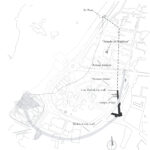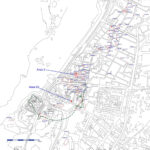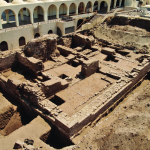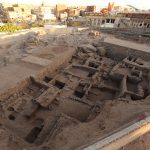ASWĀN (SYĒNĒ)
| Egyptian | Swn | Swnw |
| Greek | Συήνη |
| Coptic | souan |
| Latin | Syene | Siene |
| Arabic | أسوان |
| English | Syene | So(u)ene | Kaine Syene | Assuan | Aswan |
| DEChriM ID | 64 |
| Trismegistos GeoID | 2207 |
| Pleiades ID | 786123 | PAThs ID | 128 |
| Ancient name | Syēnē |
| Modern name | Aswān |
| Latitude | 24.0885745 |
| Longitude | 32.901491 |
| Date from | - |
| Date to | - |
| Typology | City |
| Dating criteria | - |
| Description | Ancient Syēnē is located on the eastern bank of the Nile, adjacent to the island of Elephantinē, in the southern area of the modern town of Aswān. The site was famed in antiquity for the granite found in the area, with quarrying activity archaeologically attested from the Old Kingdom, with the earliest material uncovered at the site also belonging to this period (von Pilgrim et al. 2008: 309; von Pilgrim and Müller 10th season: 11-12; id 11th season: 5). At the end of the third century, when Diocletian repositioned the southern border of Egypt, and thus of the Roman Empire, Syēnē became a border town, apparently serving as a garrison for three auxiliary units totaling to some 1500 men, with apparent traces identified of Roman defences (von Pilgrim et al. 2010: 194). Even prior to the movement of the border, however, the site seems to have been host to the military, with a possible Persian fort identified in Area 13A (von Pilgrim et al. 2008: 313). The inclusion of the site here, in the 4CARE database, is only tenuous given the fact that the single object of relevance has a less than clear provenance (see artefact 475). It is connected simply with ‘Aswan’, with it possibly having come from Syēnē, but also plausibly from either Elephantinē or the Monastery of St. Simeon on the west bank. The latter location is perhaps the most likely given that the records associated with the object refer to Ugo Monneret de Villard, who excavated at the monastic site between 1924 and 1926 (Monneret de Villard 1927). It is nevertheless beneficial to provide an overview of Syēnē due to its likely relevance with regards to fourth century Christianity. The ancient town is home to three temples, which are also three of the main built features of the site, spanning from the Ptolemaic to the Roman periods. In Area 1 is the Temple of Isis, constructed during the reign of Ptolemy III, in Area 2, situated outside the Roman town, is the small temple of Tiberius, and in Area 3, the northern part of the Roman town, is a small temple dedicated to Khnum built by Domitian (von Pilgrim et al. 2004: 121). The former of the three is the most important given that a church was erected within the temple’s confines, this being the main church archaeologically attested at the site (von Pilgrim et al. 2006: 237). The point at which the temple was transformed into a church is not known with certainty, but the Christian paintings associated with the structure have been situated between the 6th and 9th centuries stylistically. Thus, assuming these images belong to the original decorative scheme of the church, its foundation can likewise be situated in this span of time, with two within the temple considered to support this date (Dijkstra and Van Loon 2013: 150-151 and n. 39. For the graffiti in the Isis temple, see Dijkstra 2012). Despite the lack of material evidence, textual sources attest to Christianity’s presence prior to this period, with Syēnē purportedly having had a bishop already by the mid-fourth century according to Athanasius’ 19th paschal letter, dated to 347, and presumably having already become a bishopric shortly after 325 (Timm 1984-1992: 222). The textual sources attest also to the apparently early commencement of monasticism in the region, with Pachomius himself said to have established a community there (Timm 1984-1992: 223). There are three additional structures which are possibly relevant to the Christian community at Syēnē. The first, and least questionable of these, is a baptistry in Area 6 which is connected to a tomb, presumably that of a martyr. Little information was published concerning this structure, but it is considered to have been abandoned by the seventh century (von Pilgrim et al. 2006: 250-262). Additionally, the presence of an apse in a late Roman public building in Area 9 can tentatively be associated with a church, but this is in no way conclusive (von Pilgrim et al. 2004: 143-144 and fig. 10). Lastly, the remains of an Egyptian temple erected by Ptolemy Philopatōr were uncovered in 1907 part of which is claimed ot have been transformed into a church, “one of the granite columns being consecrated to the new faith by having a cross within a circle sculptured in relief on it. On the capitals of other granite columns there are well-preserved examples of carved “Byzantine” designs. The granite pedestal of a statue – the bronze feet of which have left a mark on the stone – has been “Christianized” by the erasure of the inscription on it and the carving of a cross within a circle.” (PSBA 1908: 73). It is known that the blocks belonging to this structure were moved to storage in the Isis temple, eventually being published by Pernigotti (Pernigotti 1978), indicating the dismantling of the temple, and thus of the church. |
| Archaeological research | A near exhaustive overview of the archaeological research carried out at Syēnē is presented in the first publication dedicated to the work of the German-Swiss Egyptian mission; the following is largely a repetition of the information therein, with the addition and expansion of various elements (von Pilgrim et al. 2004: 119-124). Many of the earliest reports of the site date from the 18th century, with reference made to various features, namely the temple of Domitian which is the only structure which has been visible since antiquity (Norden 1737: pls. 129 and 130; Pococke 1743: 116-118 and pl. 48). The temple building was somewhat cleared by W. Hamilton in 1801 (Hamilton 1809: 66), followed by R. Richardson in 1817 (Richardson 1822: 510), eventually coming to be partially dismantled by the local Turkish governor (Mariette 1889: 6). A line was cut directly through ancient kūm as a result of the construction of the railway in the late 19th century, and in 1871, the famed Isis temple, and thus the church it contains, were discovered, with the excavation of the monument itself, finalised in 1902, conducted by the local inspectorate (von Pilgrim, C., et al. 2004: 122; Baedeker 1891: 304; de Ricci 1909: 147-153). Sabbāḫīn uncovered a paved street in 1895/6 north of the English church and east of the former railway station (Sayce 1896: 107), with excavations continued by Jouget on behalf of U. Bouriant (Cagnat 1896: 37-45). In the beginning of the 20th century, much of the medieval and late antique levels were removed in preparation for the erection of various structures, including the German hospital in Area 3. F. Zucker eventually received the concession of the site in 1907, with J. Maspero making it a condition for him to share it with Clairmont-Ganneau (Müller 1982: 8, 50). As part of town development works large number of architectural elements, stelae, and smaller finds have been retrieved, but these are devoid of topographical details (Lefebvre 1907: 103-108; id 1928: 34; Bernard 1989: 169-182; von Pilgrim et al. 2004: 123). Excavations were conducted in the area of the Isis temple in 1961 by “el-Hetta”, the director of the Museums of Upper Egypt (Leclant 1962: 203), and four seasons of work were conducted in the medieval cemeteries to the south of the town, from 1961 to 1964, as a result of infrastructure development related to the high damn (Abd al-Tawab 1977: V-VII). Visible texts and reliefs were published on various occasions throughout the 20th century (Engelbach 1921: 195; de Wit 1960: 108-119), but the first serious publication dedicated to the site was that of an Italian mission directed by E. Bresciani, who published information pertaining to the Isis temple, including details regarding architecture and texts (Bresciani and Pernigotti 1978). After this, H. Jaritz, developed an interest in the area, documenting and publishing aspects of various monuments in and around Aswan (Jaritz 1975; id 1985; id 1998), and conducting several excavations between 1987 and 1993 on the Temple of Domitian as well as the environs of the Isis temple (Jaritz and Rodziewicz 1994; id 1996). It was this work which laid the foundations for the current Swiss-German-Egyptian mission, which is undoubtedly one of the most extensive and ambitious archaeological missions in Egypt. Beginning in 2000, and still on-going, the overall goal of this long-term mission is to develop as thorough an understanding as possible of the ancient topography of the site and its historical development, while also making monuments accessible to tourists through the creation of a central archaeological zone. Rescue excavations have comprised a large part of the mission’s work, with tens of construction projects halted for the sake of salvaging archaeological information. The mission is directed by C. von Pilgrim and Mohamed el-Bialy of the local antiquities’ inspectorate, with fieldwork directed by W. Müller. |
• Dijkstra, J. H. F. 2007. “New Light on the Patermouthis Archive from Excavations at Aswan. When Archaeology and Papyrology Meet.” The Bulletin of the American Society of Papyrologists 44: 179-209.
• Dijkstra, J. H. F. 2009. “Structuring Graffiti: The Case of the Temple of Isis at Aswan.” In Ägyptologische Tempeltagung: Structuring Religion, edited by R. Preys, 79-93. Wiesbaden: Harrassowitz.
• Dijkstra, J. H. F. 2010. “The Reuse of the Temple of Isis at Aswan as a Church in Late Antiquity.” Journal of the Canadian Society for Coptic Studies 1: 33-46.
• Dijkstra, J. H. F. 2012. Syene 1. The Figural and Textual Graffiti from the Temple of Isis at Aswan. Mainz: Philipp von Zabern.
• Dijkstra, J. H. F. 2013. “Graffiti als tekens van persoon-lijke devotie in het Oude Egypte.” Ta-Mery 6: 54-71.
• Dijkstra, J. H. F. and G. J. M. van Loon. 2010. “A Church Dedicated to the Virgin Mary in the Temple of Isis at Aswan?” Eastern Christian Art 7: 1-16.
• Dijkstra, J. H. F. and G. J. M. van Loon. 2013. “The Christian Wall Paintings from the Temple of Isis at Aswan Revisited.” In Christianity and Monasticism in Aswan and Nubia, edited by G. Gabra and H. Tekla, p. 137-156. Cairo: the American University in Cairo Press.
• Forstner-Müller, I. 2012. “Nubian Pottery in Aswan.“ In Nubian Pottery from Egyptian Cultural Contexts of the Middle Kingdom and Early New Kingdom, Proceedings from a Workshop held at the Austrian Archaeological Institute of Cairo, 11-12 December 2010, edited by I. Forstner-Müller and P. Rose, 9-82. Vienna: Österreichisches Archäologisches Institut.
• Grossmann, P. 1980. Elephantine II: Kirche und spätantike Hausanlagen im Chnumtempelhof. Beschreibung und typologische Untersuchung. Mainz: Phillip von Zabern.
• Jaritz, H. 1975. “Untersuchungen zum ‘Tempel des Domitian’ in Assuan.” Mitteilungen des deutschen archäologischen Instituts, Abt. Kairo 31: 237-257, pls. 78-83.
• Jaritz, H. 1986. “On Three Townsites in the Upper Thebaid.” Cahiers de recherches de l’Institut de papyrologie et égyptologie de Lille 8: 37-42.
• Jaritz, H. and M. Rodziewicz. 1994. “Syene – Review of the Urban Remains and its Pottery.” Mitteilungen des deutschen archäologischen Instituts, Abt. Kairo 50: 115-141, pls. 16-22.
• Jaritz, H. and M. Rodziewicz. 1996. “Syene. Investigation of the Urban Remains in the Vicinity of the Temple of Isis (II).” Mitteilungen des deutschen archäologischen Instituts, Abt. Kairo 52: 233-249 and pls. 41-44.
• Maccoull, L. S. B. 1990. “Christianity at Syene/Elephantine/Philae.” The Bulletin of the American Society of Papyrologists 27, 1: 151-162.
• Novacek, J., K. Scheelen-Novacek, M. Hepa, M. Schultz, C. von Pilgrim, and W. Müller. 2019. “Roman and Late Antique Burials from the Old Town of Aswan.” Anthropologie 57: 3-51.
• von Pilgrim, C., K.-C. Bruhn, and A. Kelany. 2004. “The Town of Syene. Preliminary Report on the 1st and 2nd Season in Aswan.” Mitteilungen des deutschen archäologischen Instituts, Abt. Kairo 60: 119-148.
• von Pilgrim, C., K.-C. Buhl, J. H. F. Dijkstra, and J. Wininger. 2006. “The Town of Syene. Preliminary Report on the 3rd and 4th Season in Aswan.” Mitteilungen des deutschen archäologischen Instituts, Abt. Kairo 62: 215-277, and pls. 43-52.
• von Pilgrim, C., K.-C. Buhl, and A. Kelany. 2004. “The Town of Syene. Preliminary Report on the First and Second Season in Aswan.” Mitteilungen des deutschen archäologischen Instituts, Abt. Kairo 60: 119-148, pls. 14-19.
• von Pilgrim, C., R. Colman, W. Müller, J. Novacek, A. de Pontbriant, and M. Schultz. 2010. “The Town of Syene. Report on the 7th Season in Aswan.” Mitteilungen des deutschen archäologischen Instituts, Abt. Kairo 66: 179-224.
• von Pilgrim, C., M. Hepa, and W. Müller. Forthcoming. “Report on the 19th Season of the Joint Swiss-Egyptian Mission in Syene/Old Aswan (2018/2019).” Draft accessible online: https://swissinst.ch/downloads/Report%20Swiss_Egyptian%20Mission%20ASWAN%202019.pdf
• von Pilgrim, C., M. Hepa, W. Müller, and S. Pfeiffer. Forthcoming. “Report on the 16th Season of the Joint Swiss-Egyptians Mission in Syene/Old Aswan (2015/2016). ASAE. Draft accessible online: https://swissinst.ch/downloads/Report%2016th%20season%202015_16.pdf
• von Pilgrim, C., M. Hepa, W. Müller, J. Novacek, and K. Scheelen-Novacek. Forthcoming. “Report on the 17th Season of the Joint Swiss-Egyptian Mission in Syene/Old Aswan (2016/2017).” Draft accessible online: https://swissinst.ch/downloads/Report%20Swiss_Egyptian%20Mission%20ASWAN%202017.pdf
• von Pilgrim, C., M. Hepa, J. Novacek, K. Novacek-Scheelen, W. Müller, and S. Torallas-Tovar. Forthcoming. “Report on the 18th Season of the Joint Swiss-Egyptian Mission in Syene/Old Aswan (2017/2018).” Draft accessible online: https://swissinst.ch/downloads/Report%20Swiss_Egyptian%20Mission%20ASWAN%202018.pdf
• von Pilgrim, C., D. Keller, S. Martin-Kilcher, F. M. El-Amin, and W. Müller. 2008. “The Town of Syene: Report on the 5th and 6th Season in Aswan.” Mitteilungen des deutschen archäologischen Instituts, Abt. Kairo 64: 305-356.
• von Pilgrim, C., M. Marée, and W. Müller. Forthcoming. “Report on the 15th Season of the Joint Swiss-Egyptian Mission in Syene/Old Aswan (2014/2015).” Draft accessible online: https://swissinst.ch/downloads/Swiss%20Institute%202014_2015.pdf
• von Pilgrim, C. and W. Müller. 2010. “Report on the Eighth Season of the Joint Swiss-Egyptian Mission in Syene/Old Aswan.” Annales du Service des Antiquités de l’Égypte 84: 317-342.
• von Pilgrim, C., W. Müller, and L. Werlen. 2013. “The Town of Syene. Report on the 8th Season in Aswan.” Mitteilungen des deutschen archäologischen Instituts, Abt. Kairo 67: 125-161.
• von Pilgrim, C. and W. Müller. Forthcoming. “Report on the Ninth Season of the Joint Swiss-Egyptian Mission in Syene/Old Aswan (2008/2009).” ASAE. Draft accessible online: https://swissinst.ch/downloads/Report%209th%20Season_2008-2009.pdf
• von Pilgrim, C. and W. Müller. Forthcoming. “Report on the Tenth Season of the Joint Swiss-Egyptian Mission in Syene/Old Aswan (2009/2010).” ASAE. Draft accessible online: https://swissinst.ch/downloads/Report%20on%20the%20Tenth%20Season%20of%20the%20Joint%20Swiss_Egyptian%20Mission%20in%20Syene_Old%20Aswan%20(2009_2010).pdf
• von Pilgrim, C. and W. Müller. Forthcoming. “Report on the Eleventh Season of the Joint Swiss-Egyptian Mission in Syene/Old Aswan (2010/2011).” ASAE. Draft accessible online: https://swissinst.ch/downloads/Report%20on%20the%20Eleventh%20Season%20of%20the%20Joint%20Swiss_Egyptian%20Mission%20in%20Syene_Old%20Aswan%20(2010_2011).pdf
• von Pilgrim, C. and W. Müller. Forthcoming. “Report on the 13th Season of the Joint Swiss-Egyptian Mission in Syene/Old Aswan (2012/2013).” ASAE. Draft accessible online: https://swissinst.ch/downloads/Swissinst_Report%20Aswan%202013.pdf
• von Pilgrim, C. and W. Müller. Forthcoming. “Report on the 14th Season of the Joint Swiss-Egyptian Mission in Syene/Old Aswan (2013/2014).” ASAE. Draft accessible online: https://swissinst.ch/downloads/Report%2014th%20Season%202013_2014.pdf
• von Pilgrim, C., W. Müller, and H. Schwaiger. Forthcoming. “Report on the 12th Season of the Joint Swiss-Egyptians Mission in Syene/Old Aswan (2011/2012). ASAE. Draft accessible online: https://swissinst.ch/downloads/SwissInst_Report%20Aswan%202012.pdf
• Timm, S. ed. 1984-1992. Das Christliche-Koptische Ägypten in Arabischer Zeit: Eine Sammlung Christicher Stätten in Ägypten in Arabischer Zeit unter Ausschyss von Alexandria, Kairo, des Apa-Mena-Klosters (Der Abu Mina), der Sketis (Wadi n-Natrun) und der Sinai-Region. Vol. 1, 222-235 (Aswān). Weisbaden: Dr Ludwig Reichert.


 Json data
Json data







